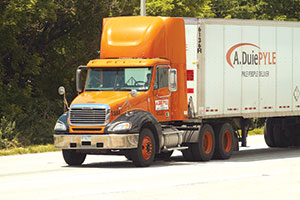Senior Reporter
Diesel Rises 0.3¢ to $1.983; First Increase in 14 Weeks

The U.S. diesel average rose 0.3 cent to $1.983 last week, the first increase in 14 weeks, the Department of Energy reported. Two fleet executives told Transport Topics they did not expect to see pump prices to spike but did share concerns about how regional price and tax variances can create business pressures.
Despite diesel’s uptick last week, it was 91.7 cents a gallon cheaper than a year earlier, DOE said after its Feb. 22 survey of fueling stations. Prior to last week’s increase, diesel had fallen 50.2 cents over 14 consecutive weeks.
Randy Swart, chief operating officer at A. Duie Pyle Inc., said the national average price increase did not necessarily signal the start of higher prices.
“I think it is going to bounce back and forth. It goes up a little based on some [crude oil] news somewhere,” Swart said. “Then it comes down a little bit . . . and someone is still feeding the glut into the system.”
His preference is for price stability.
“It helps us estimate where our costs are going to be, and to help our customers understand where their costs [of goods] are going to be because the variability is a negative,” Swart said.
He noted the less-than-truckload carrier primarily operates in the Northeast and uses about 36,000 gallons of diesel a day.
He said a disadvantage related to diesel prices is the varied amounts in taxes the states in his region put on the fuel.
“It really goes more to the taxation [policies] of the various states as opposed to what the rack price might be. For instance, Pennsylvania, which is one of our largest areas, has some of the highest tax rates for diesel in the nation,” Swart said.
In fact, six of the 17 states with the highest diesel fuel taxes nationally are clustered in the Northeast, according to the American Petroleum Institute. All are led by Pennsylvania, where 65.1 cents of state tax is added to the standard 24.4 cents of federal tax for a total of 89.5 cents a gallon.
A. Duie Pyle ranks No. 75 on the Transport Topics Top 100 list of the largest U.S. and Canadian for-hire carriers.
DOE figures showed the higher average price was in California, at $2.288, despite dropping 2.8 cents last week. It is 30.5 cents above than the national average.
Al Nunes, president of truckload carrier A.C. Trucking Inc. in Manteca, California, told TT his concern with diesel prices rests with large shippers that use the national average to set surcharges.
“And here we are in California with 30 cents-plus above the national average. That’s always a difficult thing for us to deal with,” he said. “They tell us to raise our rates to accommodate the cost, but then we’d be noncompetitive with others bidding.”
Nunes said he manages that situation by “continually reminding [shippers] what the price of fuel is in California over and above national average.”
In some cases, he said that is effective, but sometimes “we decide we don’t want to haul for them.”
A.C. Trucking serves California and seven Western states. It also provides drayage from Northern California intermodal rail ramps.
DOE also reported the average price of regular gasoline rose 0.6 cent to $1.73 but is 60.2 cents cheaper than a year earlier.
The agency estimates vehicle miles traveled in the United States in 2015 were almost 4% above the 2007 level, but overall gasoline consumption has not exceeded its previous peak. Improvements in light-duty vehicle fuel economy are largely responsible for this outcome, DOE said.
Also last week, crude oil futures on the New York Mercantile Exchange rose back above $30 a barrel, even as domestic oil inventories were nearing record highs.
“The result may be lower crude oil prices and higher price volatility in the near future,” DOE reported.




